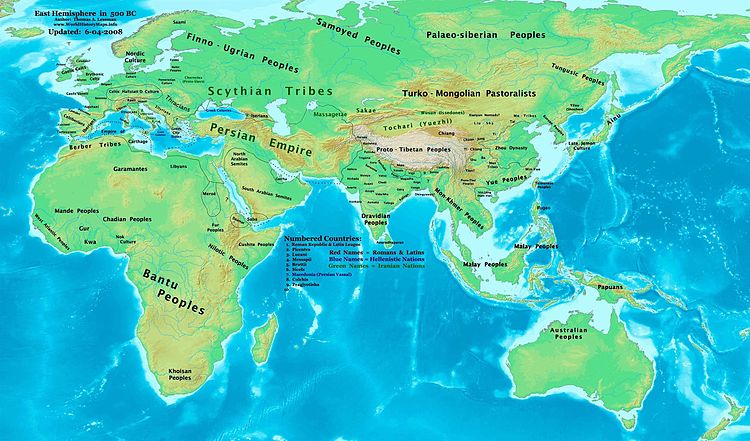Old age
The ancient age is the set of events from the beginning of writing and recorded human history that extends to Late Antiquity. The span of recorded history is approximately 5,000 years, beginning with Sumerian cuneiform. Ancient history covers all the continents inhabited by humans in the period 3000 BCE. C. - 500 AD The three-age system periodizes ancient history into the Stone Age, Bronze Age, and Iron Age, with recorded history generally considered to begin with the Bronze Age. The beginning and end of the three ages varies between world regions. In many regions, the Bronze Age is generally considered to have begun a few centuries before 3000 BC. C., while the end of the Iron Age varies from the beginning of the first millennium BC. C. in some regions until the end of the first millennium d. C in others.
During the Ancient Age, hundreds of civilizations of great importance arose and developed on all continents, many of which generated products, institutions, knowledge and values that are still present today, from Sumer (IV millennium BC) and Ancient Egypt, passing through the ancient Vedic civilizations in India, Ancient China, ancient Greece and Rome, the Achaemenid Empire in Persia, Ancient South America, among many others.
In the course of the Ancient Ages, cities and the urbanization process, the State, law and law, as well as great religions such as Buddhism and Christianity arose.
Old Age Features
Whatever the criteria used, coinciding in time and place, both processes crystallized at the beginning of urban life (cities much larger in size, and different in function, from Neolithic villages); in the appearance of political power (palaces, kings) and organized religions (temples, priests); in a complex social stratification; in great collective efforts that require the provision of compulsory work; in the establishment of taxes and long-distance trade (everything that has come to be called the "urban revolution"). This level of social development, which was first reached in Sumer from 0 B.C. C. (a propitious space for the constitution of the first competitive city-states from the Neolithic substrate), had already been developing in the Fertile Crescent for four millennia. From them, and from successive contacts (both peaceful and violent) of peoples neighbors (sedentary-agricultural or nomadic-livestock cultures that are traditionally named with terms of questionable validity, more typical of linguistic families than of human races: Semites, Camites, Indo-Europeans, etc.), the first states of great territorial extension were formed., up to the size of multinational empires.
Similar processes took place at various times depending on the geographical area (successively Mesopotamia, the Nile valley, the Indian subcontinent, China, the Mediterranean basin, pre-Columbian America and the rest of Europe, Asia and Africa); in some particularly isolated areas, some present-day hunter-gatherer peoples have not yet left prehistory while others plunged violently into the modern or contemporary age by colonizations of the centuries XVI to XIX.
The peoples chronologically contemporary to the written History of the Eastern Mediterranean can be the object of protohistory, since the sources written by Romans, Greeks, Phoenicians, Hebrews or Egyptians, in addition to archaeological sources, allow it to be done.
Classical Antiquity is located at the height of Greco-Roman civilization (5th century B.C. to the 5th century B.C. II AD) or, broadly speaking, for its entire duration (century VIII BC to V d. c.). It was characterized by the definition of innovative sociopolitical concepts —those of citizenship and personal freedom, not for everyone, but for a minority sustained by slave labor—, unlike the fluvial empires of ancient Egypt, Babylon, India or China, for for which the imprecise category of «Asian mode of production» was defined, characterized by the existence of an all-encompassing power at the top of the empire and the payment of tributes by the peasant communities subject to it, but with a free social condition (since even though there is slavery, does not represent the main workforce).
End of Ancient Age
The end of the Ancient Ages in Western civilization coincides with the fall of the Western Roman Empire, in the year 476 (the Eastern Roman Empire survived the entire Middle Ages until 1453 as the Byzantine Empire), although such discontinuity was not Observe in other civilizations. Therefore, the later divisions (Middle Ages and Modern Ages) can be considered valid only for that one, while most of Asia, Africa and America are subject to their own periodization in their history.

Some culturalists extend European Late Antiquity to the VI and VII, while the French "mutationist" school extends it to sometime between the IX and XI. Different interpretations of history emphasize economic issues (transition from the slave-owning mode of production to the feudal mode of production, since the crisis of the 3rd century), political or ideological (disappearance of the empire and installation of the Germanic kingdoms from the V), religious (replacement of polytheistic paganism by theocentric monotheisms: Christianity —century IV— and later Islam —VII— century), philosophical (ancient philosophy through medieval) and artistic (evolution from ancient art —classical— to medieval art —paleochristian and pre-Romanesque—).
Ancient Age Geography
The civilizations of Antiquity are geographically grouped by historiography and archeology in areas where different peoples and cultures were especially linked to each other; although the areas of influence of each one of them came to interpenetrate on many occasions and go much further, forming empires of multicontinental dimensions (the Persian Empire, that of Alexander the Great and the Roman Empire), thalassocracies ("government of the seas") or trade routes and long-distance exchange of products and ideas; although always limited by the relative isolation between them (obstacles of deserts and oceans), which becomes radical in some cases (between the Old World and the New World). Ancient navigation, especially the nature and extent of the expeditions that primitive Polynesian cultures necessarily had to undertake (at least as far as Easter Island), is still a controversial issue. On some occasions, experimental archeology has been used to prove the possibility of contacts with America from the Pacific. Other concepts of application discussed are the priority of diffusionism or endogenous development for certain cultural phenomena (agriculture, metallurgy, writing, alphabet, currency, etc.) and the application of evolutionism in archaeological and anthropological fields.
Ancient Near East
The Ancient Near East or Ancient East is the term used to name the areas of western Asia and northeast Africa where civilizations prior to the classical Greco-Roman civilization arose, and which is currently called the Near East or Middle East. For the same region, Vere Gordon Childe coined the name Fertile Crescent, defining it as the area where the Neolithic Revolution (0 BC) and later the Urban Revolution (0 BC) arose first. They are the current countries of Iraq, part of Iran, part of Turkey, Syria, Lebanon, Israel, the Palestinian Territories, Jordan, Arabia and Egypt. Chronologically, it is understood as a period that goes from the beginning of historical civilizations around 0 B.C. C. (in this area the appearance of writing, cities and temples is simultaneous to the Bronze Age) until the expansion of the Achaemenid Empire in the century VI a. c.
Ancient Mesopotamia
The mouth of the Tigris and Euphrates in Lower Mesopotamia gave rise to the accumulation of alluvial deposits in the area of marshes that are gradually gaining ground from the sea off the receding coast of the Persian Gulf (currently more than a hundred kilometers from its place in the IV millennium BC, and with the two confluent rivers —Shatt al-Arab—). The area was propitious (with the condition of maintaining a great capacity for social organization for collective work in the construction of hydraulic works such as pipelines, irrigation and drainage) for the development of the Sumerian city-states (Ur, Uruk, Eridú, Lagash). These, in competition with each other and with the nomadic peoples of the surrounding steppes and deserts (those from the south and west included by historiography in the broad ethnic concept of Semites and those from the east in the Iranian area where the Elamite civilization gradually formed), as well as with the nuclei that formed further north (Babylon) and even further north in Upper Mesopotamia (Nineveh); they were developing the constitutive characteristics of civilization (complex society) and the state (political-ideological superstructure): temple, priestly class and organized religion, border, territorial war, army, propaganda, taxes, bureaucracy, monarchy, constructions such as walls and ziggurats; and the feature that marks the beginning of the story: the recording of memory in writing.
The dynamics of territorial growth led to the formation of empires, which in their claim to monopolize power, described themselves as a spatial continuum "between the small sea and the great sea" (the Persian Gulf and the Mediterranean), in more or less reliable enumerations of towns annexed, destroyed, dispersed, rejected, subjected, tributaries, or simply business partners, allies, or diplomatic contacts.
Ancient Persian
Mountain ranges, plateaus, steppes, and deserts characterize a difficult physical environment between the Tigris River to the west, the Persian Gulf to the south, the Indus River to the east, and the Elburz Mountains, Caspian Sea, and Oxus River to the north. However, they are also the land route that connects the Near East with Central Asia and South Asia (more difficult, the maritime connection being more used); and through those areas, ultimately, with the Far East. The extensive Persian or Iranian region would play a key role in the Indo-European theory, of debated validity, which assumed the existence of an ancestral group of peoples from the steppes who shared common features (linguistic, ethnic, cultural and even structure of thought), essentially cattle farmers (they placed great value on cows, horses and dogs), with a patriarchal, hierarchical and triadic social structure (visible even in their pantheon of gods), who staged a gigantic expansion that would include the conquest of India by the Aryans; that of Europe by the predecessors of the Greeks, Latins, Celts, Germans, and Slavs; and that of Mesopotamia, Anatolia, the Levant and Egypt by Medes and Persians.
Ancient Anatolia and Armenia
The Anatolian peninsula, a land route between Asia and Europe, from which it is separated by the Bosphorus Strait and the numerous Aegean islands, with which it has always maintained a cultural continuum (of which the Achaeans and Trojans of myth are examples Homeric), was at the heart of the innovations of the Neolithic Revolution and the Urban Revolution, developing powerful states that entered into relationship and competition with the Mesopotamians and even with Egypt. To the north, the Black Sea coast (Pontus for the Greeks and Romans), hosted myths such as the Golden Fleece found in Colchis. The Caucasus mountain range puts it in contact with the distant Eurasian plains.
Ancient Mediterranean Levant
The easternmost coastal area of the Mediterranean, due to its location between Africa and Asia and its favorable physical conditions, acted as a "corridor" between the sea and the desert, highly compartmentalized, although with fluvial valleys running north-south (those of the Jordan and the Orontes), which made possible terrestrial communications between Africa, Asia and Europe. This role had been fulfilled since the Paleolithic and the Neolithic (Jericho), and it was accentuated with the first civilizations. The great empires of Egypt, Mesopotamia and Anatolia had their geostrategic contact zone in this area. The critical situation at the end of 0 a. C. allowed the development of powerful local civilizations with a strong personality and influence on subsequent historical development (traits such as the alphabet or monotheism), with a projection far superior to its geographical extension or population.
Ancient Syria, Jordan and Arabia
Between the Tigris and the Lebanon Range begins a vast desert area that stretches south to the Arabian Peninsula. It represents an insurmountable obstacle to the development of agriculture beyond small areas of widely scattered oasis, except in the Yemen area (Arabia Felix —'Happy Arabia'—). The economic activities that developed and allowed the formation of a peculiar civilization were, therefore, nomadic herding and the lucrative caravan routes of long-distance trade that connected all parts of the ancient world through the ports of the Red Sea, the Gulf of Aden and the Persian Gulf (open to the Indian Ocean —navigation to India and Indonesia—, to East Africa —where the relationship with Eritrea and Ethiopia was very close— and to the eastern coast of Egypt —Berenice—), and cities from the interior such as Aleppo, Damascus, Apamea, Petra or Palmyra (which connected with the Mediterranean Levant).
- Pre-Islamic Arabia
- Seleucidal Empire
- Syria (Roman province)
- History of Syria
- History of Jordan
- History of Yemen
- Qataban
- Kingdom of Saba
- Himyar
- Awsan
- Dilmun
- Nabatites
- Lihyan
- Magan
- Petra
- Palmira
- Incense route
Ancient Nile Valley
"Egypt is a gift of the Nile" (Herodotus), since few civilizations had such a determining relationship with a river. Its annual flood allowed the fertility and extremely high population density of a narrow strip that runs through the uninhabited North African desert ("desertized" in the postglacial period) from the southern falls to the northern delta. The duality between Upper Egypt and Lower Egypt forged, on an extraordinarily stable peasant society and linked by collective work in hydraulic works, institutions and a culture characterized by the sacralization of the figure of the pharaoh, the strength of the temples, an efficient bureaucracy and a complex religion from the afterlife. Within a great continuity throughout millennia (which has sometimes been interpreted as homogeneity or even stereotyping, with very few exceptions —the Amarna period—), a repeated dialectic between unity and disintegration was maintained in the cyclical evolution of the phases of Egyptian history, with periods of splendor and crisis.
- Ancient Egypt
- Hicsos
- People of the Sea
- Nubs
- Kingdom of Kush
- Kingdom of Aksum
- Kingdom of Napata
- Kingdom of Meroe
- Trucks
- Afro-Asian expansion
- Quote languages
- Egyptian languages
The opening of the Tutankhamon sarcophagus by Howard Carter in 1923, one of the most spectacular moments of archaeology. It was an intact tomb, and precisely that of the pharaoh whose brief reign (1336-1327 B.C.) meant the return to the traditional orthodoxy of the Egyptian religion after Ajenaton's hertic parenthesis.
Ramses II, the most active of the Pharaohs of the new Empire, in a relief of Abydos. The outer expansion led to the north of Palestine, facing the Hittites in the famous battle of Qadesh (centuryXIIIa. C.1274), whose uncertain outcome allowed it to be presented as a victory on both sides, forced the maintenance of an early concept of “international balance” with sophisticated diplomatic negotiations, and gave rise to an interesting justification program in artistic texts and monuments that make it the first battle of military history with enough information to be the subject of a detailed study.
Ancient Mediterranean and Europe
- Pre-Roman peoples
- Colonizing peoples
- Orientalizing
- Helenism
- Romanization
Ancient Greece

Hellade is the geographical and cultural concept that included in classical antiquity the territory inhabited by the Greeks or Hellenes, broader than present-day Greece, and that would include the European continental territory that goes from the Peloponnese to the south to a diffuse separation with Macedonia, Thrace and Epirus to the north; in addition to the islands of the Aegean Sea and the Ionian Sea and the western coast of present-day Turkey (Ionia) to the Hellespont. The Greek colonies established throughout the Mediterranean were also assimilated to the concept of Hellas; and the extensive territories of the Hellenistic monarchies of Egypt and the Near East, which had been Hellenized to a greater or lesser extent, could also be understood close to it.
Model of the structure of the Cnosos Palace. It was an astonishing palatial city located in Crete, of features never seen before (pipenett, complex position in the inner steps, dimensions far superior to other contemporary palaces, etc.), so it is believed that of minoid civilization, the Egyptians—not the Greeks— were inspired by the myth of Atlantis. Archaeological theories on the final catastrophic of mynoic culture, associated with the so-called "mynoic boiler" of the volcano that produced the current boiler of the Santorini island (sixteenth century)XVIIa. C.), they also allow their association with that myth.
Zeus, father of the gods and armed with lightning, as corresponds to the Greek mythology, presides over the Sanctuary of Olympia where in his honor they were celebrated from the centuryVIIIa. C. Olympic games, milestones marking the calendar and one of the most important legacies of classical civilization. The colossal statue of gold and ivory, 12 meters high, was due to Fidias (sixteenth centuryVa. C.), and was counted among the seven wonders of the ancient world. Destroyed in the centuryVd. C., this engraving is a recreation of modern times.
The Macedonian Empire was the most vast of the ancient world, and also the most ephemeral: it did not survive its founder, Alexander the Great. In the midst of youth, after his father Philip II of Macedonia (who had previously unified the Greek polys), he applied the effective war machine formed by this to the defeat of the Persian Empire, the enemy of the Greeks since the medical wars. His gesta expanded Greek culture through the Near East and to Central Asia and India, beginning the period called Helenism.
The stadium of Afrodisias, one of the few remains that remain of that grecorrome city, known in its time for its beautiful marble buildings. The stadium is, in fact, a mixture between a collision and a Greek track. The reason for this is because they celebrated bloody battles and at the same time games as album release.
Ancient Mediterranean Islands
Many Greek myths were located on coasts or islands located in an indefinite “extreme West” (Vulcan —Hephaistos—, Labors of Hercules —Heracles, Pillars of Hercules, Geryon, Atlas—, Atlantis, Garden of the Hesperides, Odyssey — Cyclops, Lestrygonians, Sirens, Scylla and Charybdis, Ogygia, Lotus-eaters—); others were located in a less clear direction, or rather in the eastern Mediterranean (towards the Black Sea - the Colchis of the voyages of Jason, the Argonauts and the Golden Fleece), the southern Aegean - the Crete of Minos, Daedalus, Icarus, and the Minotaur defeated by the Athenian Theseus; or of the abduction of Europa—or the Cyprus of the birth of Aphrodite).
Ancient Cyprus
- History of Cyprus
Ancient Western Mediterranean Islands
- Megalitism
- History of Corsica
- Corsos
- History of Sardinia
- Sardos
- History of Sicily (Sicilia).
- Yes
- Sicans
- He
- Aolias Islands
- History of the Balearic Islands (Balearic Islands, Balearic mushrooms, Quinto Cecilio Metelo Baleárico).
- History of Malta
- Gozo
- Djerba
- Battle of Alalia
- Magna Greece
- Battle of Hímera
- Expedition to Sicily
- Punic wars
Ancient North West Africa

- Libiophenians
- Cartago
- Kingdom of Mauritania
- Kingdom of Numidia
- Guanches
- Berber languages
Ancient Western Europe
- Germans
- British
- Pictos
- Hibernios
- Celtic
- Welsh people
- Ancient history of the Iberian Peninsula
- Palaeo-Hispanic languages
- Pre-Roman peoples of the Iberian Peninsula
- Tartesian
- Contemporary peoples to the Roman conquest of Hispania:
- Villages of the eastern and southern zone (Mediterranean strip, Pyrenees, Ebro valley, Béticas mountain ranges and Guadalquivir valley), generically called iberos: layetanos, ausetanos, lacetanos, indigetes, ilergetes, iacetans—related rather with the Aquitaines, suessetanos, sedetanos, edetanos
- People of the western zone (now Portugal) and central (central plateau and the Iberian system): célticos, lusitanos, vetones, foldernos, celltíberos, vacceos, etc.
- Villages of the north or cantabrian strip: galaicos, astures, cantabris, autrigones, várdulos, turmogos, berones, caristios, vascones, etc.
- British Roman
- Galia
- Germania
- Hispania Roman
Ancient Italy and Rome
The Roman Empire had an impact far greater than its own spatial extension (almost six million square kilometers, already one of the largest among the empires of all time) and its temporal duration (from 27 B.C. C. to 476 AD in the West and 1453 in the East); for being the political institution and the decisive economic-social formation for the conformation of Western civilization, which to a large extent can be considered its survival. Through it, its legal and institutional concepts (Roman law, Roman municipality, Roman province, Roman Senate...), artistic and cultural concepts (classical art and culture, Roman urbanism, Roman road, Roman theater, baths, aqueducts...) survived..) and the language itself (Latin). Romanization was a process that was very syncretic, since it incorporated cultural traits of the conquered peoples. In particular, he identified with the Greek civilization, which Rome recognized as superior to its own, except in political and military matters (Ex Oriente Lux, Ex Occidente Dux). In its final period, the Judeo-Christian contribution was decisive.
Etruscan Frescos de la «tumba de los leopardos» (Tarquinia), where a symposium, social custom of clear Greek influence, represented here with the colourful and festive conception of etruscan painting. The Etruscans developed a civilization with orientalizing characteristics within the italic sphere, of which they were the dominant power until Rome, the Latin capital that was subjected to Etruscan kings (Roman monarchy), was ended up imposing in the early times of the Republic (of the centuryVa. C. to the centuryIIIa. C.).
Julius Caesar's bust, the last "strong man" of the Republic (other were Cayo Mario, Sila or his main rival, Pompeyo), and immediate predecessor of the Roman Empire, who designed his heir Octavio Augusto in the form of principality (end of the century)Ia. C.). The territorial expansion of Rome and the republican civil wars socially meant the overcoming of the initial opposition between patricians and plebeyos and the constitution of a mode of slave production that covered a powerful aristocracy.
Plant of the Coliseum of Rome or Flavio Amphitheater, where 5000 spectators sat to observe bloody shows as battles between gladiators or wild beasts, and even naval battles (naumaquias). The expression panem et circensis (‘pan and circus’) declared the demagogic intention of flattering and haunting the masses of people while guaranteeing their support for the imperial figure, in a similar way as the leaders of the final phase of the Roman Republic had done.
Old Balkans and Eastern Europe

- First Metallurgical Civilizations of Southern Europe
- Iris
- Peonios
- Dacios
- Macedonios
- Traces
- Little girls
- Sármatas
- Wendos (venedi or proto Slavos).
- Kingdom of Epiro
- Pyrrican Wars
- Illegal wars
- Panonia
- Iliria
- Ilyric
- Dalmatia
- Trace
- Dacia
- Mesia
- Escitia
- Kingdom of the Ponto
- Kingdom of Bosphorus
- Spartacids
- Taurostauroi or tauri)
- History of Crimea (Crimea)
- Greek crime
- Roman crime
- Byzantium
Ancient North Eurasia
- History of Siberia
- Urálican languages
- Turkic languages
- Mongolic languages
- Ugrofine languages
- Samoan languages
Ancient Central and South Asia
The Central Asian steppes historically had a close relationship (dialectic of nomadic and sedentary peoples) with the Hindustan plain, and this with the Deccan peninsula. The land connection with the Middle East through the deserts of Iran was, on the other hand, more compromised, while navigation through the Arabian Sea allowed more fluid routes. However, all of them were experienced, sometimes in the course of the same expedition, as was the case of Alexander the Great (326 BC).
- Central Asia
- South Asia
- Culture of the Indo Valley
- Arios
- Magadha
- Mauritanian Empire
- Turkic peoples
- Hunos and Heftalitas
- Little girls
- Civilization of the Oxus (Bactria-Margiana archaeological complex).
- Culture of Andronovo
- Corasmia
- Bactriana
- Sogdiana
- Margiana
- Beluchistan
- Gedrosia
- Tocarios
- Empire kushān
- Indo-European languages
- Sanskrit
- Elamo-dávida languages
- History of Afghanistan
- History of Uzbekistan
- History of Turkmenistan
- History of Tajikistan
- History of Pakistan
- History of India
- Silk road
- Hinduism
- Rig-veda
- Majabharata
- Ramayana
- Buddhism
- Jainism
- Grecobudismo
- Nestorianism
Ancient Far East
The geographical isolation of this area is marked by the highest mountain ranges in the world: the Himalayas, the Altai, the Hindu Kush, the Tian Shan, the Pamirs and the Karakorum; and some of the largest and driest deserts: the Taklamakan and the Gobi. Even maritime communications between India and China are difficult (exposure to monsoons, long navigation due to the interposition of the Indochina peninsula and the Malacca peninsula, which requires crossing areas such as the Sunda Strait or the Strait of Malacca). Even so, there were contacts, as evidenced by the continuity of trade routes and the diffusion of technologies, alphabets and religions (Hinduism to Southeast Asia and Buddhism to Tibet, China and Japan). However, the difficulty of this contact was perceived as the result of a journey of mythical dimensions (Journey to the West).
- History of China
- History of Japan
- History of Korea
- History of Vietnam
- History of Thailand
- History of Cambodia
- History of Laos
- History of Indonesia
- History of Burma
- History of Tibet
- History of Mongolia
- Sino-tibetan languages
- Turkic languages
- Mongolian languages
- Tungu languages
- Austrian languages
- Malaysian and Polynesian languages
- Tocarios
- Mongoles
- Ordos
- Altái; oiratos and calm village.
- Turkic peoples
- Tunguish peoples
- Hunos
- Uigures
- Xiongnu
- Etnia han
- Ainu
- Japanese
- Koreans
- Cingales
- Javanes
- Malays
- Hold them.
- Cambodian
- Vietnam
- Traditional Chinese religion
- Chinese mythology
- Confucionismo
- Taoism
- Buddhism
- Majaiana
- Japanese mythology
- Shinto
- Zen
- Hinduization of the Indochina Peninsula
Ancient Sub-Saharan Africa
The Sahara desert and the difficulties of the upper course of the Nile represented two formidable geographical barriers that caused a very important cultural discontinuity between North Africa and Sub-Saharan Africa. However, they were sufficiently permeable to allow contact via caravan routes with the area of the Niger River and the Gulf of Guinea, and contact through the Red Sea with Eritrea and Ethiopia, areas strongly linked to the Arabian Peninsula. The special case of Madagascar is a consequence of the origin of the Malagasy population, related across the Indian Ocean with other Malayo-Polynesian populations.
Ancient America
In pre-Columbian America, two distinct centers of civilization arose: the Andean region around 0 B.C. C. and Mesoamerica around 0 B.C. c.
Ancient Andes
The first known complex societies of South America, Sechín and Caral, arose around the IV millennium BCE. C. on the central coast of present-day Peru. In the XII century B.C. C., the Chavín or Cupisnique culture spread throughout the coast and the central Andes, giving way after its decline to various regional styles such as Paracas Vicús, Cajamarca, Moche, Recuay, Lima, Pucará, Nazca, Huarpa and Tiahuanaco. Around the VII century, the influence of Nazca and Tiahuanaco on Huarpa, added to local developments in agriculture and irrigation, led to the emergence of Huari as a large urban and militarized state that expanded its rule over much of the region formerly influenced by Chavín, except for the southern Tiahuanacota. At the fall of the Huari and Tiahuanaco in the X century, political power fragmented into various domains with diverse cultural styles. Lambayeque, Chimú, Chancay, Ychsma, Maranga and Chincha developed at this time on the coast, along with Chachapoyas, Huamachuco, Huancas, Chancas, Collas, Lupaca, Chiribaya and Incas in the highlands. Around 1438, the Inca Pachacuti led the expansion of the Inca Empire to the south of present-day Colombia and northwestern Argentina. The long cultural succession has an abrupt change with the Spanish Conquest in the 16th century.
Mesoamerica
- Colossal head n.o1 of the Xalapa Museum.jpg
Olmeca colossal head (Xalapa, Mexico).
The isthmus-Colombian area
- Intermediate area
- Muisca culture
- Tayrona Culture
- Culture San Agustín
Ancient Caribbean
Ancient Oceania
- Oceania
- Pacific Ocean
- History of Oceania
- Melanesia
- Polynesia
- Micronesia
- Lapita
- History of Tonga
- Australian Aboriginal
- Maorís
- Mitology samoana
- Hawaiian religion
- Tangaloa
- Austrian languages
- Malaysian and Polynesian languages
- Ocean languages
The extraordinary extension of Polynesian colonization in the Pacific (Pacific exploration, Polynesian navigation), in a triangle whose vertices are in New Zealand, Hawaii and Easter Island, and whose center is Tahiti. The ethnographic unity of this culture is seen in physical, linguistic, ideological, social and economic anthropological characteristics (determined crops and livestock—cerdos and birds).
The expedition of Thor Heyerdahl at the Kon-tiki was an imaginative attempt of archaeology or experimental anthropology that sought to check the possibility of travel between South America and the Pacific, based on the ability to navigate rafts similar to the "totora balls" of Lake Titicaca. However, the most common interpretation of archaeological and anthropological evidence maintains that the original settlement of the population of America was carried out by land, and from north to south, while that of Oceania was carried out from west to east.
Symbols of the Maori gods. Tangaroa would be a divinized hero whose genealogy is preserved in Polynesian myths, maintained by oral tradition, and that allow to describe and even date successive migrations that would begin from some point in Indonesia (possibly the Isle of Java, has been calculated in the centuryIIIa. C.) and would continue with island radiation on island to reach the maximum expansion in the centuryXII.
Maps and timeline of the Ancient Ages
Historical formations around the Mediterranean and Near Eastern space
On a white background, the periods considered prehistoric (without the presence of writing —the existence of proto-writing in some cultures is a controversial issue—), on a slightly shaded background the historical periods (with the presence of writing —the first writings and alphabets, in pink letters—), on a background of different colors, the different empires (political entities of great extension, which reaches at least one of the areas considered in this scheme). The table follows the Western narrative, that is, ending with the fall of the Western Roman Empire.
| Century or Millennium | Aegean and Balkans | Peninsula Itálica | From the Alps to the Pyrenees | Iberian Peninsula | Northwest Africa | Egypt | Levante and Asia Menor | Mesopotamia | Iran and Central Asia |
|---|---|---|---|---|---|---|---|---|---|
| V millennium a. C. | Neolithic and Calcholytic (prehistoric) Danubiano Sesklo, Dímini, Vinča, Gumelnitsa | Neolithic (prehistoric) Cardial ceramics bocca quadrata | Neolithic (prehistoric) ceramic bands Cardial ceramics, Rössen, Chassey, The Hoguette | Neolithic (prehistoric) Cardial ceramics | Neolithic (prehistoric) | Neolithic (prehistoric) Predining | Neolithic and Calcholytic (prehistoric) | Neolithic and Calcholytic (prehistoric) The Obeid | Neolithic and Calcholytic (prehistoric) |
| IV millennium a. C. | Neolithic and Calcholytic (prehistoric) Dispilio Gumelnitsa | Neolithic (prehistoric) bocca quadrata | Neolithic (prehistoric) megalitism Chassey, Pfyn | Neolithic (prehistoric) tombs of grave | tehenu Paleta de Tehenu (egipcia, protohistoric) | Calcolytic Predining Protodinas hierarchical writing | Calcolytic (prehistoric) Uruk Yemdet Nasr | Calcolytic Uruk Yemdet Nasr writing cuneiforme | Calcolytic (prehistoric) Protoelamite |
| III millennium a. C. | Calcolytic (prehistoric) Cycladic minoa civilization Bronze Age (prehistoric) | Calcolytic (prehistoric) vasoaniforme, Remedello, Rinaldone, Gaudo, Laterza, Polada | Calcolytic (prehistoric) vasoaniforme, Horguen, SOM | Calcolytic (prehistoric) vasoaniforme megalitism The thousands | Calcolytic (prehistoric) (prehistoric) temehu | Arcaico or Tinita Ancient Empire Hieral writing Intermediate I | Akkadian Empire | Arcaic or Protodystic Dinastics Sumerian cities Akkadian Empire Sumerian rebirth | Protoelamite Akkadian Empire Sumerian rebirth |
| II millennium a. C. | Aegean and Balkans | Peninsula Itálica | From the Alps to the Pyrenees | Iberian Peninsula | Northwest Africa | Egypt | Levante and Anatolia | Mesopotamia | Iran and Central Asia |
| CenturyXX.a. C. | minoa civilization | Age of Bronze (prehistoric) apennic culture, Polada | Age of Bronze (prehistoric) vasoaniforme | Bronze Age (prehistoric) vasoaniforme | Bronze Age (prehistoric) | Middle Empire | Hits | Assyrian Empire | Elam |
| CenturyXIXa. C. | minoa civilization | apennic culture, Polada (prehistoric) | vasoaniforme (prehistoric) | The Argar (prehistoric, Southeast) | Middle Empire | Assyrian Empire | Assyrian Empire | Elam | |
| CenturyXVIIIa. C. | minoa civilization | apennic culture, Polada (prehistoric) | vasoaniforme (prehistoric) | The Templates (prehistoric, South Meseta) | Middle Empire Intermediate II | Hits Hurritas Aleppo protosinatic writing | Babylonian Empire | Elam | |
| CenturyXVIIa. C. | minoa civilization linear A | apennic culture, Polada (prehistoric) | vasoaniforme (prehistoric) | Cogots I (prehistoric, North Plateau) | Intermediate II Hicsos | Hits Hurritas Aleppo | Babylonian Empire | Elam | |
| CenturyXVIa. C. | minoa civilization micenics linear B | Terramaras (prehistoric) | (prehistoric) | Vila Nova (prehistoric, under Tajo) | Intermediate II New Empire | Hits Mitani linear C | Mitani casitas | Elam | |
| CenturyXVa. C. | minoa civilization micenics | Terramaras (prehistoric) | (prehistoric) | Atalaia (prehistoric, southwest) | New Empire | Hits Mitani New Empire | Mitani casitas | Elam | |
| CenturyXIVa. C. | minoa civilization micenics | Terramaras (prehistoric) | (prehistoric) | pretalayotic culture (prehistoric, Balearic) | mashauash | New Empire | Hits New Empire | Middle Assyrian empire | Elam |
| CenturyXIIIa. C. | micenics peoples of the sea Doria invasion? Age of Iron (prehistoric) | urn fields proto-Villanova italian peoples (prehistoric) | (prehistoric) | Talayotic culture (prehistoric, Balearic) | libu | New Empire peoples of the sea | Hits New Empire peoples of the sea Qadesh battle Ugandan alphabet | Middle Assyrian empire | Elam |
| CenturyXIIa. C. | Dark Age (prehistoric) dolls | proto-Villanova italian peoples (prehistoric) | Hallstatt ("cells," prehistoric) | urn fields (prehistoric, Northeast) | libu | New Empire | Age of Iron frigids, lids, Hittites, Phoenician, Philistines, Aramaic Phoenician alphabet | Middle Assyrian empire Aramaic | Elam Middle Assyrian empire |
| CenturyXIa. C. | Dark Age (prehistoric) jonios | proto-Villanova italian peoples (prehistoric) | Hallstatt ("cells," prehistoric) | Fundación de Cádiz (first Phoenician colony) | libu | New Empire Intermediate III | frigios, lids, fenicios Kingdom of Israel Aramaic | Aramaic | Elam |
| I millennium a. C. | Aegean and Balkans | Peninsula Itálica | From the Alps to the Pyrenees | Iberian Peninsula | Northwest Africa | Egypt | Levante and Anatolia | Mesopotamia | Iran and Central Asia |
| CenturyXa. C. | Dark Age (prehistoric) Greek polys iliters | Age of Iron (prehistoric) Villanova italian peoples | Hallstatt ("cells," prehistoric) | Preiberos Celts (prehistoric) | paleo-bereberes, pre-libics | Intermediate III | frigios, lids, fenicios Kingdom of Israel Kingdom of Judah alphabet paleohebreo Aramaic and Neohitian kingdoms | Aramaic kingdoms | Elam |
| CenturyIXa. C. | Dark Age Greek polys Greek alphabet iliters | "gifts" or "ceals" etruscos italian peoples (prehistoric and protohistoric) | Hallstatt ("cells," prehistoric) | Preiberos Celtic (prehistoric) | Phoenician colonization foundation of Cartago (protohistory) paleo-bereberes, pre-libics | Intermediate III | frigios, lids, fenicios Kingdom of Israel Kingdom of Judah Aramaic and Neohitian kingdoms first Arab alphabets | Aramaic kingdoms New Assyrian Empire | Elam New Assyrian Empire |
| CenturyVIIIa. C. | Arcaico first olympiad Homer polys and colonies Ionic League iliters | "gifts" or "ceals" italian peoples etruscos alfabeto etrusco foundation of Rome Greek colonies | Age of Iron Hallstatt ("cells," prehistoric) | Age of Iron (prehistoric) Celtic Iber Greek colonies Phoenician colonies Tartessos (protohistory) | Phoenician colonies Cartago paleo-bereberes, pre-libics | Intermediate III demotic writing New Assyrian Empire | frigid, lid Nineveh Cautivity New Assyrian Empire Urartu Aramaic and Neohitian kingdoms Aramaic alphabet | New Assyrian Empire | Elam Empire medo |
| CenturyVIIa. C. | Arcaico tyrants Greek legislators iliters, Macedonians, tricks | italian peoples etruscos Roman Monarchy Latin alphabet Samnitas Magna Greece | Hallstatt ("cells," prehistoric) | Celtic Iber Greek colonies Phoenician colonies Tartesian paleohispanic writings | Phoenician colonies Cartago paleo-bereberes, lipids Cirenaica (greco-egipcios) | Intermediate III New Assyrian Empire Late or Saita | frigios, lids, fenicios Assyrian Empire Neo-Babylonian Empire | New Assyrian Empire Neo-Babylonian Empire | New Assyrian Empire Neo-Babylonian Empire Empire medo |
| CenturyVIa. C. | Arcaico tyrants Athenian democracy Burning Empire iliters, Macedonians, tricks | italian peoples etruscos Roman Monarchy Roman Republic Magna Greece | Hallstatt ("cells," prehistoric) Antipolis and Massilia (first Greek colonies, protohistory) | Celtic Iber Greek colonies Tartesian Carthaginian Empire | Battle of Alalia Carthaginian Empire paleo-bereberes, lipids Cirenaica (greco-egipcios) | Late or Saita Burning Empire | Tiro site captivity of Babylon Neo-Babylonian Empire Burning Empire | Neo-Babylonian Empire Burning Empire | Burning Empire |
| CenturyVa. C. | Burning Empire Medical Wars League of Delos Pelopones League Peloponnese War Lilies, kingdom of Macedonia, betrayals | italian peoples etruscos Roman Republic Magna Greece | La Tène (prehistoric) Greek colonies | Celtic Iber Greek colonies Carthaginian Empire | Carthaginian Empire paleo-bereberes, lipids, guarantors Cirenaica (greco-egipcios) | Burning Empire | Burning Empire | Burning Empire | Burning Empire |
| CenturyIVa. C. | Queronea battle Empire of Alexander iliters | etruscos Roman Republic italian peoples Roman Conquest of Italy Magna Greece | La Tène (prehistoric) Greek colonies | Celtic Iber Greek colonies Carthaginian Empire | Carthaginian Empire paleo-bereberes, lipids, guarantors Cirenaica (greco-egipcios) | Burning Empire Empire of Alexander | Burning Empire Battle of the Gránico Battle of Issos Tiro site Gaza site Empire of Alexander | Battle of Gaugamela Empire of Alexander | site of the Sogdiana Rock Empire of Alexander |
| CenturyIIIa. C. | Kingdom of Macedonia Kingdom of Epiro League Aquea Etolia League iliters | Pyrrican Wars Carthaginian Empire Punic wars Roman Republic | Gosh Greek colonies Punic wars Roman Republic | pre-Roman peoples Greek colonies Carthaginian Empire Punic wars Roman Republic | Carthaginian Empire Battle of Zama paleo-bereberes, lipids, guarantors Cirenaica (greco-egipcios) | ptolemaic dynasty (greco-egipcios) | Seleucidal Empire Kingdom of Pergam | Seleucidal Empire | Seleucidal Empire births Greekbactrians Indogriegos |
| CenturyIIa. C. | Kingdom of Macedonia Kingdom of Epiro League Aquea Etolia League Macedonian wars iliters Roman Republic | Roman Republic | Gosh Roman Republic | celtiberos and lusitanos Numancia site Roman Republic Books and Astures | Cartago Third Punic War Roman Republic Kingdom of Numidia Kingdom of Mauritania paleo-bereberes, lybics, getulos, guaamantes Cirenaica (greco-egipcios) | ptolemaic dynasty (greco-egipcios) | Kingdom of Pergam Kingdom of Armenia Kingdom of the Ponto Maccabees Nabatian | Seleucidal Empire births | births Greekbactrians Indogriegos |
| CenturyIa. C. | Roman Republic High Roman Empire | Roman Republic High Roman Empire | Gosh War of the Galias Battle of Alesia Roman Republic High Roman Empire | Roman Republic Books and Astures Cantabrian wars High Roman Empire | Roman Republic Kingdom of Numidia Kingdom of Mauritania Yugurta War paleo-bereberes, lybics, getulos, guaamantes Cirenaica (greco-egipcios) High Roman Empire | dynasty ptolemaica Battle of Actium High Roman Empire | Mytridental wars Roman Republic High Roman Empire Nabatian | births | births tocarios Indogriegos |
| I Millennium | Aegean and Balkans | Peninsula Itálica | From the Alps to the Pyrenees | Iberian Peninsula | Northwest Africa | Egypt | Levante and Anatolia | Mesopotamia | Iran and Central Asia |
| CenturyI | High Roman Empire | High Roman Empire | High Roman Empire | High Roman Empire | High Roman Empire Kingdom of Mauritania | High Roman Empire | High Roman Empire First Judeo-Roman war Nabatian | births | births tocarios Indogriegos |
| CenturyII | High Roman Empire | High Roman Empire | High Roman Empire | High Roman Empire | High Roman Empire | High Roman Empire | High Roman Empire | births High Roman Empire | births Kushán Empire |
| CenturyIII | Under Roman Empire | Under Roman Empire | Under Roman Empire | Under Roman Empire | Under Roman Empire | Under Roman Empire Empire of Palmira | Under Roman Empire Empire of Palmira | Sassanian Empire Under Roman Empire Empire of Palmira | Sassanian Empire Kushán Empire |
| CenturyIV | Eastern Roman Empire | Roman Empire of the West | Roman Empire of the West | Roman Empire of the West | Roman Empire of the West | Eastern Roman Empire | Eastern Roman Empire | Sassanian Empire Eastern Roman Empire | Sassanian Empire Kushán Empire |
| CenturyV | Eastern Roman Empire | Roman Empire of the West Ostrogot Kingdom | German invasions Visigoth Kingdom of Tolosa | German invasions Swedish Kingdom Visigoth Kingdom of Tolosa | Vandal Kingdom of Africa | Eastern Roman Empire | Eastern Roman Empire | Sassanian Empire Eastern Roman Empire | Sassanian Empire White hunos |
Fiction
Literature
William Shakespeare composed several plays set in antiquity: Julius Caesar, Antony and Cleopatra, Coriolanus, Titus Andronicus, among others. Miguel de Cervantes did the same in El cerco de Numancia; but it was more common in classical French theater: Pierre Corneille (Horacio, Cinna, etc.) and Jean Racine (La Tebaida, Andromache, Phaedra, among others), from which —and based on classical models and ancient texts by Terence and Plautus— the academic conventions that set the model for neoclassical theater were established. from the 18th century.
The historical novel that emerged in romanticism had its main setting in the Middle Ages (see medievalism), but the setting was also sought in different civilizations of the Ancient Ages.
Many of the novels were adapted for film or television:
- Sinuhé, the EgyptianMika Waltari.
- CreationGore Vidal.
- AlexandrosValerio Massimo Manfredi.
- The last days of PompeiiEdward Bulwer Lytton.
- Ben-HurLewis Wallace.
- What vadis?Henryk Sienkiewicz.
- I, Claudio and Claudio, the god, and his wife MesalinaRobert Graves.
- Juliano the ApostateGore Vidal.
The editorial success of historical issues has multiplied the appearance of best sellers of the genre, especially those related to the military history of Rome.
Cinema
- Intolerance
- Land of PharaohsHoward Hawks.Land of the Pharaohs, 1955). The popularity of Egypt has produced many films whose relationship with ancient Egypt is rather lateral (such as the numerous versions of Egypt) The mummyfrom Karl Freund, 1932.
- 300. There is a previous cinematographic version of the same event (The Lion of Sparta or The 300 Spartans1962.
- Alexander the Great
- Cabiria, by Giovanni Pastrone (1914).
- SpartacusStanley Kubrick (1960).
- Golfus de Rome
- Cleopatra
- Caligula
- Satiricón
- The Fall of the Roman EmpireAnthony Mann (1964).
- Gladiator
- The last legion
The adaptation of myths from ancient times has given rise to a special film genre, which includes titles such as Troy, Clash of the Titans, Jason and the Argonauts, etc., as well as biblical cinema: The Ten Commandments (by Cecil B. DeMille, 1923 and 1956), Solomon and the Queen of Sheba, Samson and Delilah, among others.
There are also different adaptations of the gospels: The Greatest Story Ever Told, The Sacred Robe, The Gospel According to Saint Matthew, The Passion of the Christ, etc. (See Category:Jesus films.)
The name peplum (from the Greek garment called peplo in Spanish) refers to a cinematographic subgenre in which the setting in Antiquity is a simple excuse for a low-budget adventure film in which anachronisms and other inaccuracies to the story are abundant (for example: Hercules, from 1958, and Hercules, Samson, Maciste and Ursus, from 1964). The characteristics of the genre have led to the making of numerous sequels and parodies.
Both these and the higher-level ones were popularly called "Roman films" (even if they were set in Greek times or any other ancient time), and their viewing in "neighborhood cinemas" with continuous and double sessions program or in the summer cinemas had a notable role in the sentimental education of youth from the late fifties to the seventies of the XX century , reflected in works such as those by Terenci Moix (a Egyptomaniac and mythomaniac, specifically Elizabeth Taylor, an actress who played Cleopatra). In this sense, the Spanish singer-songwriter Joaquín Sabina has a song entitled Una de romanos, characterized by nostalgia for past youth.
Television
- Me, Claudio (miniserie)
- Rome (TV)
Cartoon
- 300 (1998, comic by Frank Miller), which is based on the film.
- Asterix the Galo (also adapted to cinema on multiple occasions).
- The Jabato
Contenido relacionado
First punic war
Salvador Sanchez (boxer)
Pablo Neruda
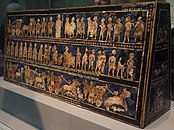
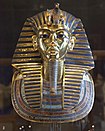
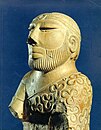


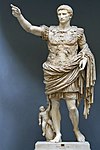
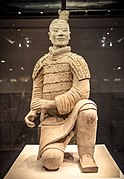
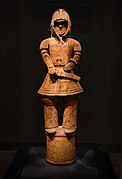


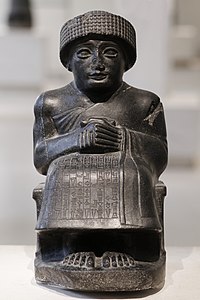
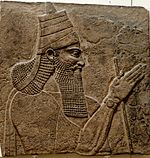
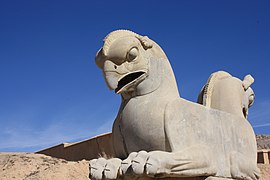




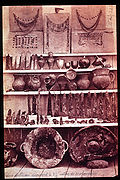




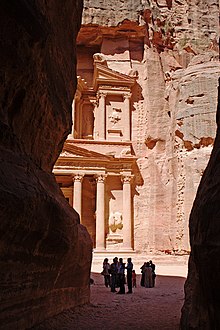

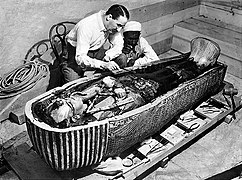





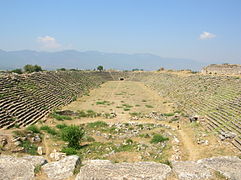
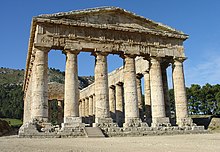










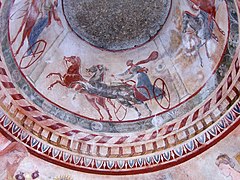
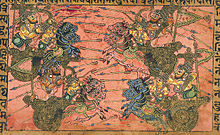
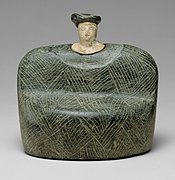













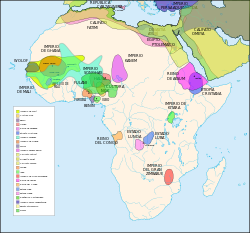




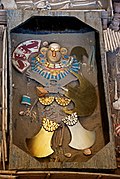



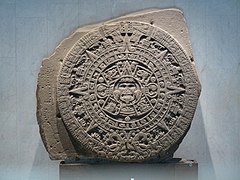

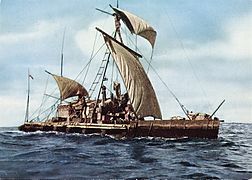
![Símbolos de los dioses maoríes. Tangaroa sería un héroe divinizado cuya genealogía se conserva en los mitos polinesios, mantenidos por la tradición oral, y que permiten describir e incluso datar sucesivas migraciones que comenzarían desde algún punto de Indonesia (posiblemente la Isla de Java, se ha calculado en el siglo III a. C.) y continuarían por radiación de isla en isla hasta alcanzar la máxima expansión en el siglo XII.[12]](https://upload.wikimedia.org/wikipedia/commons/thumb/f/f2/Maorigodsymbols.jpg/311px-Maorigodsymbols.jpg)
